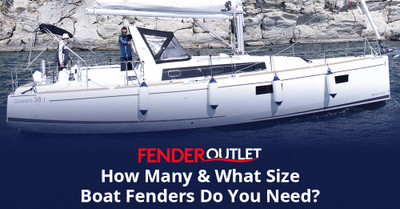19th Aug 2025
If you’ve ever wondered how many fenders you actually need for your boat - or struggled to choose the right size - you’re not alone. It’s one of the most common questions we hear from boaters across the UK, whether they’re cruising narrow canals, locking through rivers, or mooring at tidal marinas.
The good news? There are some tried-and-tested rules of thumb that make choosing the right fenders simple. Let’s dive in.
How Many Fenders Do You Need?
A basic guideline is at least three fenders as a minimum and one fender for every 10 feet of boat length. That means a 30 ft cruiser should have around 3 fenders, while a 60 ft barge or yacht will need 6 or more. It’s always wise to carry a spare or two - especially if you moor in busy marinas or lock frequently.
What Size Fender Should You Choose?
Another rule of thumb is based on your boat length:
- Cylindrical fenders → 1 inch of diameter per 5 ft of boat length.
- Round fenders (ball fenders) → 2 inches of diameter per 5 ft of boat length.
Example Sizes:
- 20 ft narrowboat → Cylindrical fenders 4–5″ in diameter, or 8″ round fenders.
- 35 ft motor cruiser → Cylindrical fenders 7–8″ in diameter, plus 10–12″ round fenders for bow/stern protection.
- 65 ft Dutch barge → Cylindrical fenders 14–18″ in diameter, plus larger round fenders (20–24″) for corners and lock work.
UK Mooring Conditions to Consider
Not all moorings are equal - your boat’s setup should reflect how and where you use it.
Canal & River Locks: Fender boards are strongly recommended. Hanging a wide wooden plank from two large fenders spreads the load and prevents brickwork or bolts damaging your hull.
Tidal Marinas: Opt for larger diameter fenders - tide height changes mean your boat may ride against pontoons differently throughout the day.
Narrowboats: Slimmer beam means you can use slightly smaller fenders, but don’t skimp on number - locks and walls can be unforgiving.
Steel Barges & Heavy Cruisers: Bigger, heavier hulls = bigger, tougher fenders. Go for 16–18″ diameter where possible.
Boat Fender Placement Tips:
- Hang fenders so the widest part meets the rub strake, not dangling too low in the water.
- Place one at each quarter (bow and stern) and one at the beam’s widest point, then fill in the gaps.
- Round fenders are ideal for corners and locks; cylindrical fenders protect long runs of hull.
- Always adjust height for the wall, pontoon, or boat you’re alongside.
Caring for Your Fenders
Looking after your fenders is a simple but important part of boat maintenance. Well-maintained fenders will last longer, look better, and most importantly, keep giving your boat the protection it needs.
Start with the basics: always make sure your fenders are inflated correctly. They should be firm enough to absorb impact but still have a little give when pressed - never inflated rock-hard, as this can weaken the seams and shorten their life.
It’s also worth checking the air pressure monthly, especially on larger fenders. Even good-quality fenders can slowly lose air over time, so a quick squeeze and top-up with a hand pump keeps them performing at their best.
After each trip, particularly in tidal or salty waters, rinse your fenders with fresh water. This prevents salt, mud, and algae from building up, which can cause unnecessary wear and staining.
For extra protection, consider fitting fender socks. These fabric covers not only reduce scuffing on your hull but also help keep the fenders themselves looking clean and tidy. They’re particularly useful for darker-hulled boats, where black marks from fenders are more visible.
You can also add fender ropes and adjustable clips to make repositioning easier, especially in marinas where pontoon heights vary. Fender baskets or racks are another handy accessory, allowing you to stow fenders neatly when they’re not in use and keeping decks clutter-free.
Finally, remember to rotate your fenders from time to time, so the same ones aren’t always taking the brunt of the wear. This spreads out the usage and extends their lifespan.
With the right care, and a few useful fender accessories your fenders will stay in top condition season after season, keeping your boat safe and looking its best.
Final Thoughts:
The right number and size of fenders is your boat’s first line of defence against knocks, scrapes, and expensive hull damage. As a rule:
- 1 per 10 ft of boat length.
- Cylinders = 1″ diameter per 5 ft length.
- Rounds = 2″ diameter per 5 ft length.
From narrowboats on the canals to barges on the Thames, investing in the right fender setup makes mooring easier, safer, and far less stressful. If you have any questions, do not hesitate to contact us - our highly experienced team are on hand to answer any questions you may have.



